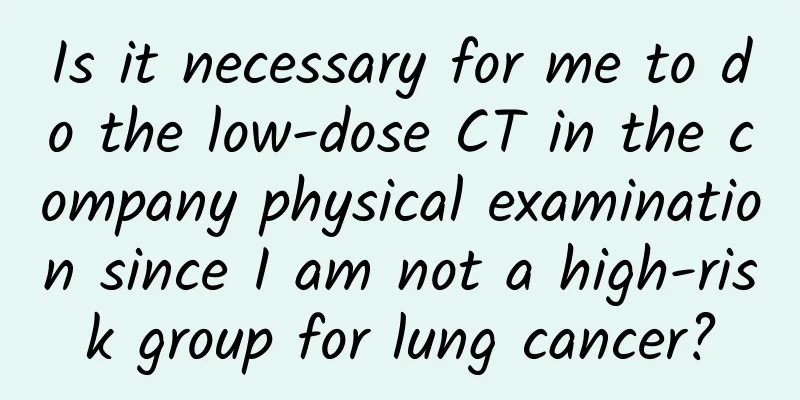Is it necessary for me to do the low-dose CT in the company physical examination since I am not a high-risk group for lung cancer?

|
On November 19, 2020, the 42nd patient education live broadcast of TopMD's "Let's Meet the Doctor" discussed the topic of "Is it necessary to be afraid of ground glass nodules"? This episode is a special program for TopMD 2020 International Lung Cancer Awareness Month. The expert guesting in the live broadcast room is our old friend: Professor Chen Haiquan, Director of the Institute of Thoracic Tumors at Fudan University and Director of the Department of Thoracic Surgery at the Affiliated Cancer Hospital of Fudan University. Are ground-glass nodules the most dangerous type of all lung nodules? Are multiple ground-glass nodules more dangerous than a single one? How should ground-glass nodules be checked? If you are not a high-risk group for lung cancer, how should you use low-dose CT to check? Do you need to take medicine if you find ground-glass nodules? Professor Chen has conducted a lot of research guided by clinical problems for many years and has published more than 190 research papers in top international academic journals, of which 16 articles have been cited 20 times by 10 international guidelines, solving many practical problems in clinical practice, changing clinical practice, improving patients' long-term survival and quality of life, and having a great impact internationally. In this live broadcast, Professor Chen brought his latest research on ground-glass nodules in the lungs and explained ground-glass nodules clearly! This live broadcast was broadcast simultaneously on 9 platforms of TopMD's all-media matrix: Sina Kandian, Tencent News, Tencent Video, Sohu Video, Qutoutiao, Jinri Toutiao, Xigua Video, and Baidu Health, with a total of 654,762 views! The entire live broadcast attracted great attention from netizens, and patients left nearly 100 messages and questions in the live broadcast room! (Some messages from TopMD lung cancer patient group and TopMD live broadcast room) (Partial online viewing volume and homepage recommendations) We have carefully edited this live broadcast according to topics of concern to everyone and broadcast it again on the entire network. Today is episode (4): I don’t have any lung cancer patients in my family and I don’t smoke. Is it necessary to do low-dose CT in the physical examination? How should people who are not at high risk of lung cancer be checked? Former smokers aged 55 to 77, with a smoking index of 30 pack-years and less than 15 years of quitting smoking, are all at high risk of lung cancer. Now there is more and more popular science about lung cancer, and everyone knows that people at high risk of lung cancer need to undergo lung cancer screening every year through low-dose CT. But what everyone doesn’t know is: “I am not in the high-risk group for lung cancer, but my unit’s physical examination package includes a low-dose CT scan. Should I do it or not?” I believe this is also a problem that many people are currently experiencing. Before answering this question, we need to first understand this low-dose CT scan in the physical examination package that is confusing you. Lung cancer has always been a difficult problem both at home and abroad. The high incidence and mortality are mainly due to limited screening methods, which cannot achieve early detection and early treatment. Medical experts have been doing a lot of research since the 1950s, hoping to find a way to detect lung cancer early and reduce lung cancer mortality. After the failure of chest X-ray, sputum exfoliated cell experiments, bronchoscopy and other studies, the National Lung Screening Trial (NLST) of the United States finally announced the conclusion of the study in 2011: low-dose CT screening for lung cancer can reduce the lung cancer mortality rate by 20% in high-risk groups. The NELSON study in the Netherlands also showed that the lung cancer mortality rate of men who received low-dose CT screening could be reduced by 24%, and the lung cancer mortality rate of women could be reduced by 59%. The milestone conclusion made low-dose CT widely used in lung cancer screening, and in the subsequent years of practice, it was proved that it was necessary to carry out low-dose CT screening in high-risk groups for lung cancer. If you are not a high-risk group for lung cancer, is it necessary to have a low-dose CT scan? Is it a benefit for the company to provide such a physical examination? Professor Chen Haiquan's team recently published a research conclusion: It is necessary to screen non-high-risk groups, but screening needs to follow certain strategies. This article is very practical, and today we will share Professor Chen's research conclusion with everyone. Why is it necessary to have a low-dose CT scan even if you are not a high-risk group? First, let me share with you two studies that the remarkable Professor Chen Haiquan once led his team to do: The first study: From August 2013 to August 2014, low-dose CT screening was performed on 11,332 residents in several communities in Minhang District, Shanghai. The conclusion was that the incidence of primary lung cancer in non-smokers was 336.97/100,000, compared with 159.06/100,000 in smokers. The second study: Regular health examinations of 8,392 hospital employees from six hospitals in different regions of China (3 in Shanghai, 1 in Shandong, 1 in Jiangsu, and 1 in Guangdong) were conducted using low-dose CT between 2012 and 2018. The conclusion was that the detection rate of lung cancer in women was significantly higher than that in men (2.5% vs 1.3%, P = 0.001). In addition, this second study had the same conclusion as the first study just mentioned: the detection rate in non-smokers was higher than that in smokers (2.2% vs 1.4%, P = 0.092). Data released by the Shanghai Center for Disease Control and Prevention also supports Professor Chen's findings, showing a significant increase in the incidence of lung cancer in young non-smoking women. Some studies in Japan and South Korea have similar results. In other words, the incidence of lung cancer in non-high-risk groups is not low. At least in Asia, the high incidence of lung cancer in non-high-risk groups should be taken seriously! In the outpatient clinics of many large hospitals, we often encounter young lung cancer patients around 30 years old. Some of them are discovered only after the disease has metastasized, while some young patients develop metastasis again within a short period of time after surgery. Li et al. also retrospectively analyzed 103 lung cancer patients aged 30 years and under who were admitted to the Cancer Hospital of the Chinese Academy of Medical Sciences from November 2013 to October 2018. Among them, 8 patients (8.1%) had local recurrence (2 cases, 2.3%) and distant metastasis (6 cases, 6.8%). It is not only a clinical phenomenon, but studies have indeed shown that lung cancer in young people is easily overlooked, so it is discovered later and leads to poor treatment outcomes. Professor Chen Haiquan also met many young lung cancer patients in the outpatient clinic. Two patients can illustrate this problem. One patient is a 14-year-old girl who had a chest CT scan at a local hospital in May 2018 because of persistent fever and cough. The scan showed a 6mm ground-glass nodule in the right lower back lung segment. After one year of observation, the nodule still existed and was 2mm larger than before. After 3 months of further observation, there was no obvious change in the nodule. In August 2019, a thoracoscopic sublobar resection was performed, and the postoperative pathology showed microinvasive adenocarcinoma. Another patient was not so "lucky". This was a 38-year-old woman. A 3cm mixed ground-glass nodule was found on low-dose CT. She immediately underwent thoracoscopic right upper lobectomy with mediastinal lymph node dissection. Postoperative pathology showed adenocarcinoma, with lymph node metastasis in group 12 (1/9), and TNM stage T2aN1M0 (IIB stage). From the two results, we can find that if the latter had received lung cancer screening and pre-invasive surgery 5-10 years ago, the outcome would be completely different. If the former had not had a chest CT scan by chance, it is easy to imagine what kind of outcome this ground glass nodule would have brought to the child 10 or 20 years later! As to why non-smoking women have a high incidence of lung cancer, medical experts at home and abroad are still working together to find the answer. Before finding the truth and prevention methods, it is indeed necessary to check a low-dose CT to help us detect and treat the lesions early! We also need to understand that the biological behavior of lung cancer is divided into three types: "indolent", "low-invasive", and "aggressive". From a dynamic perspective, these three types of lung cancer are not static in their growth process. In 2019, literature reported that indolent and low-invasive ground-glass nodules may still progress to invasive tumors requiring surgical treatment even after a 5-year follow-up period. This also shows the necessity of lung cancer screening in non-high-risk populations. How should non-high-risk people undergo low-dose CT scans? Yearly? Monthly? Professor Chen Haiquan told us that the epidemiology, pathogenesis, and pathophysiology of lung cancer in non-smokers are completely different from those in smoking-related lung cancer. Therefore, the screening strategy for non-high-risk groups must be different from that for high-risk groups. When it comes to low-dose CT screening, there are two unavoidable issues. The first is the radiation damage of CT. The effective dose of low-dose CT radiation is about 1.5 mSv per examination, and the dose of enhanced CT may reach 8mSv; PET-CT is about 14 mSv. The most worrying thing about radiation is its cumulative effect. Data show that for every 2,500 people screened, CT radiation may cause about 1 cancer death. The second problem is overdiagnosis and overtreatment. An Italian observational study suggests that the overdiagnosis rate associated with lung cancer screening may reach 25%, and an overdiagnosis rate estimated based on the NLST data model is also around 18.5%. Overdiagnosis may lead to unnecessary overtreatment. For example, many people panic about nodules, affecting their normal work and life, resulting in unnecessary surgical resection of benign nodules, prematurely labeling them as "lung cancer patients", increasing their risks and pain, wasting medical resources, and increasing the socioeconomic burden. The International Association for the Study of Lung Cancer (IASLC) believes that the benign surgery rate should be controlled below 15%. According to the monthly MM (morbidity and mortality) report data from the Fudan University Cancer Hospital where Professor Chen Haiquan works, the benign surgery rate for lung nodules in their hospital is basically controlled at 6%-8%, which is very good. Many of the first-time patients in Professor Chen Haiquan's clinic have undergone three CT scans within three months, one for physical examination, one at a secondary hospital, and one at a tertiary hospital. Some of these CT scans may have been enhanced, and this does not include the immediate follow-up CT scans. Therefore, it is necessary to avoid unnecessary radiation damage, overdiagnosis, and overtreatment. This research conclusion is very timely and important! The following two strategies are hoped to provide guidance to clinicians and the general public: Strategy 1: The first low-dose CT scan can be performed at around 30 years of age. It is recommended that non-high-risk people have their first low-dose CT examination around the age of 30. In many cases, this examination is done unintentionally, perhaps for the purpose of examining or differentially diagnosing other diseases, or for a company health check, etc. A single low-dose CT scan has low radiation and low cost, and the examination results will serve as the benchmark and evidence for future screening, follow-up, and reexamination. However, the "degree" of low-dose CT examination must be properly grasped, after all, no matter how low the dose is, there is still radiation dose. Strategy 2: The interval between follow-up visits should be extended If the first low-dose CT result is negative, the interval will vary according to age and other risk factors, with the goal of minimizing the number of follow-up CTs before diagnosis and increasing the chance of detecting cancer progression. For people under 50 years old, the interval can be extended to 5-10 years. For people aged 50-60 years, if there are no other risk factors, the interval is 5 years; if there is at least one other risk factor, the interval is shortened to 3 years. For people aged 60 and 70, the recommended interval is three years and two years respectively. For people over 70 years old, regardless of other risk factors, the recommended interval is 2 years. If a nodule is found on the first low-dose CT, it is another process of nodule evaluation and diagnosis and treatment. A very clear screening strategy diagram for non-high-risk groups! If you are still confused about this question, do you need to move your fingers and forward it to your friends who are also confused? There is a type of lung cancer that is too late to be treated once it is discovered, and the surgical effect is not ideal. Is this caused by ground glass nodules? There is a type of lung nodule that must be paid attention to once it is discovered! In tomorrow's program, Professor Chen will tell you which type of nodules is the most dangerous. [Legal Statement] This column is originally created by TopMD, and the copyright belongs to the producer. Any form of reprinting, editing and modification is prohibited without authorization, otherwise legal liability will be pursued. This program is for the purpose of popularizing medical knowledge and cannot replace the doctor's face-to-face consultation. The relevant content is for reference only. |
<<: Drink more honey and eat less ginger in autumn
Recommend
HootSuite: Instagram Advertising Statistics for 2022
Instagram advertising potential reach reaches 1.8...
Leucorrhea regular pus balls
Many women will find pus-filled sacs when doing r...
What happens when a large amount of blood clots flow out?
Whether during menstruation or non-menstruation, ...
What causes weak spleen and stomach? What are the symptoms of weak spleen and stomach?
Weak spleen and stomach are common in life. Irregu...
Female left waist pain
The lady felt a needle-like pain on the left side...
What causes pain in the lower part of the body during late pregnancy?
Some pregnant women develop diseases in the late ...
The secret behind stomach pain: How much do you know about peptic ulcer?
Stomach pain, this seemingly simple symptom, may ...
What causes poor ovarian function?
What causes ovarian problems? The uterus and ovar...
How long after menopause can I do B-ultrasound
We all know that one of the signs of early pregna...
What is the artificial cycle of premature ovarian failure?
When you discover that your body is experiencing ...
There are more than 600 million patients in my country! Severe cases can cause blindness! This trouble can be prevented by getting more sun
At present, there are 1.4 billion myopic patients...
Recommended postpartum porridge
Pregnant women are weak after giving birth and ha...
Benefits of Type O blood girls
We know that different people's blood types c...
What is the best range hood? What are the requirements for choosing a range hood?
We all know that range hoods are a common kitchen...









